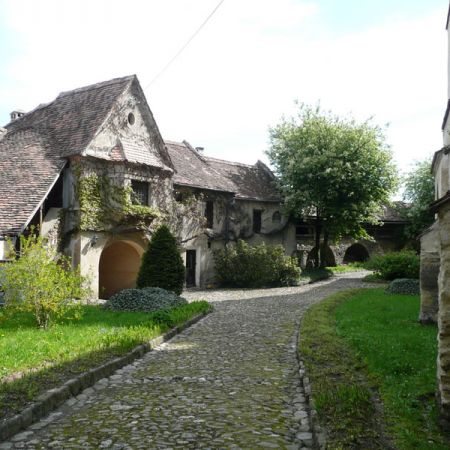Cisnadie, Romania

Cisnadie, the center of the textile industry (silk, carpets), was once one of the biggest villages in Transylvania. Urban texture of the settlement has special value, it keeps almost unaltered form centuries XII - XIV.
Fortress and the Evangelist Church
Place of worship is a Roman basilica, built approximately in the first quarter of the century XIII. A key feature is the tower high above the choir since the Roman period. In the centuries XV and XVI church has been strengthened and tower over the choir. All have since been raised and construction of defense that rises above the portals side.
The fortress around the church had three precincts. In XV century were built new walls, towers and bastions of defense.
Rasinari
Situated 12 km south-west of Sibiu, birthplace of the famous philosopher Emil Cioran.
Tourist attractions
The Village's Museum - has a collection of over 1500 exhibits - ethnographic objects and folk art. Exhibits are presented in seven rooms and are valuable testimonials about occupations and local traditional crafts.
Mausouleul Andrei Saguna (1808-1873) - Andrei Saguna -great scholar and metropolitan of Transylvania. There is located next to Holy Trinity Church.
Paltinis
Tourist resort, situated 32 km south-west of Sibiu. The winter sports resort is situated at the highest altitude (1442m) in the country. It has modern hotels, restaurants and bars. Established as a tourist resort in the Carpathian Society Transylvania in the last decade of the century, nineteenth century, more preserve four of villas clear after more than 100 years, now historic monuments.
Ski on the mountain Oncesti, arranged for competitions, provides chairlift, teleski and baby-lift. Rich ionized air, bioclimatic alpine ensure an adequate cure.
Cristian
Tourist attractions
The Village's Museum - opened in1969, exhibits a great number of pieces of folk art and ethnographic and many books of the XVII - XVIII.
Fortress village and the Evangelist Church C.A. - Former Roman Basilica (XIII century) transformed twice: first in the century XIV was altered the overall look. As the initial elements to keep lower fragment of the tower and the western portion of the Nordic collateral. Among the details of decorative art is remarked the Gothic pew the southern side of the choir. Fortification was edificated at the end of the XVI century were raised when the two enclosures with five towers. The Tower pentagonal plan dates from around the year 1580.
The Orthodox Church - the patron Annunciation - is a church hall with the altar and the tower angled in the west. The building dates from 1790, provided that the altar belongs to an old monument. The church was painted in fresco inside in 1805. Exterior painting was executed in 1790.

































